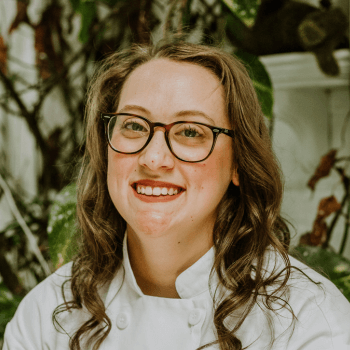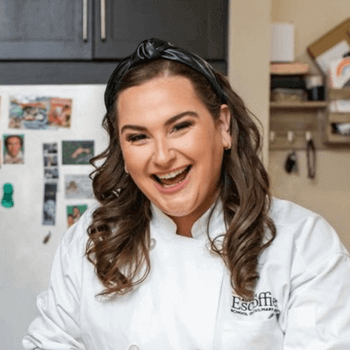Listen to This Article:
Not everyone who wants to work with food dreams of being a chef. And that’s okay! If you’re looking for a way to share your culinary knowledge with others, create your own schedule, and even maybe make some money along the way, you may want to consider starting a YouTube cooking channel.
A cooking channel can allow you to hone your entrepreneurial chops while also providing creative freedom. Want to learn more? Join us as we cover how to start a cooking channel on Youtube.
How to Start Your Cooking Channel
While you don’t necessarily need to follow these steps to start your channel, they can be a good jumping off point.
1. Choose a Theme
This could be a specific cuisine, like Italian or plant-based, or a cooking style like barbeque or quick meals. Or you can stay out of the kitchen and opt to review area restaurants or interview chefs in your region. The most important thing is that one item ties your whole channel together—when viewers see your content, they should be able to recognize your brand.
Don’t know where to start? Think about where your passions, knowledge, and consumer demand combine. For example, if your friends always ask you how you create healthy dinners for your busy family, you may cater your channel to busy parents. And if you leverage your cake decorating skills to create whimsical cakes, you may want to share your piping skills and fondant work with viewers.
“Find your niche. Because if you find that niche, you’ll go places. I found my passion, and I was able to leave my old job… Now I’m living my best life. Play to your strengths because you will succeed in life.”*
Cassie Wallace, Online Baking & Pastry Graduate
And don’t be afraid to think outside the box and put your own twist on things! Escoffier Chef Instructor Steve Konopelski has a YouTube cooking show, The Sweet Life of Steve, that highlights sweet and savory recipes along with some singing, dancing, and humor.
2. Come Up with a Content Plan
A constant stream of videos is a key part of keeping your viewers engaged. However, when it comes time to film new content, you may find yourself staring at your kitchen wondering what in the world you have to share with your viewers.
That’s where a content plan comes in. By creating a list of video ideas ahead of time, you can avoid this block sneaking up when it’s time to film. Scheduling when you will film, edit, and upload your content can also help you stay on track with keeping your food channel updated.
That begs the question, how do you come up with ideas in the first place? With your theme in mind, you can turn to various sources for inspiration—try browsing through cookbooks, thinking about dishes you make on a regular basis, and reflecting on common cooking questions others ask you. Once you have a more established channel, you can also begin creating content based on viewer questions and requests.
3. Determine Your Style
Every food influencer aims to create content that connects with viewers and encourages them to return for more. Of course, different people are drawn to various types of content, so you can’t expect your videos to be a hit with everyone. The key is to identify your ideal audience and then create content that consistently connects with them.
Regardless of if you opt for a light and comedic style that’s loaded with pop-culture references or a serious tone that’s focused on the science of cooking, pick your style and stick with it. Remember, you’re not only creating videos, you’re also creating a brand.

Neatly styling your food can help make your content shine.
4. Begin Creating Content
After laying out your cooking channel on paper, it’s time to begin creating content. While you can begin filming with a smartphone and natural lighting, you may find it beneficial to invest in equipment like a camcorder, tripod, microphone, and lighting.
Even if you have the best equipment, you still need to know how to set it up, plan your videos, and make your food shine. That’s right, YouTubers need some of the same skills as food photographers and food stylists!
When you are filming, have a plan in mind for how you will describe what’s happening. For example, if you’re making crepes, will you talk viewers through how to spread the thin batter across the pan, or will you keep quiet and add overlay text later on? Regardless of what option you choose, clear communication is key—your viewers should walk away with answers rather than more questions.
5. Keep the Content Flowing
Whether you aim to influence others via a food blog, YouTube cooking channel, or a TikTok channel, consistency is key. It often takes weeks or months for your content to reach a wider audience, but continuing to publish videos will increase the chances that viewers will find your channel.
While you’re running your cooking channel, you should continue to keep aspects like brand voice, expenses, and marketing in mind. If you find that you need a little help with the business aspects of starting and growing your channel, you may find it beneficial to enroll in a food entrepreneurship program. This program not only can help you explore topics like photography, marketing, and social media management, but it also can provide an introduction to culinary techniques and skills like mise en place and recipe development.

You can complete work like editing content and interacting with viewers from anywhere with internet access.
6. Monetize Your Platform
If you continue to create high-quality content, you should begin to notice that people are subscribing to your channel. Once you hit 1,000 subscribers, you can enroll in the YouTube Partner Program and begin to monetize your content. There are various ways to make money from your channel, including ads, channel memberships, and custom merchandise.
As you begin making money, you should consider how you can reinvest your earnings to grow your channel. Since YouTube revenue increases with the number of subscribers, investing in your channel in the short-term may lead to more revenue in the long-term.
“I chose to further my education and go to culinary school. It wasn’t an easy decision in the sense that, whenever you take on something big like that, everything can feel like, “Why did I do this?” It is so important to keep learning. You have to know what you don’t know, and be your own advocate to go and learn it yourself.”*
Lisa Spychala, Online Culinary Arts Graduate and Food Stylist
Tips for Creating a Thriving YouTube Cooking Channel
As you create your cooking channel, keep these tips in mind.
Use Descriptive Language
Since viewers won’t be able to taste your finished product, you’ll need to use everything at your disposal when it comes to describing the dishes you cook. Along with hearing sizzling bacon and seeing dripping grease, using descriptive language can help your viewers get a glimpse into how your dishes taste. Stray away from words like delicious and great, and instead choose options like smoky, succulent, and indulgent. The Escoffier Flavor Wheel–used by Escoffier online students–is a valuable tool for defining these types of attributes in a dish!
Watch Other Cooking Channels
Knowing what a good (and bad) cooking channel looks like can help you create an engaging YouTube channel. Watch multiple YouTube cooking videos while taking notes on what you do and don’t like. Pulling a few working elements from various channels can help you create a unique and successful channel.
Consider Recording Individual Steps
Rather than recording yourself preparing the entire recipe in one shot, consider breaking up your filming into multiple takes. This can make it easier to edit your video and also allows you to film from a variety of angles.
Connect with Your Audience
Creating a personal connection with your viewers can encourage them to like, subscribe, and return for more. Some ways to create this connection include requesting content ideas, encouraging viewers to share their feedback in the comments, and shouting out specific viewers in your videos.
Get Started with Your Entrepreneurial Goals
Regardless of whether you’d like to inspire others to bake birthday cakes for their loved ones or make individuals laugh with witty commentary about the latest food trends, starting a YouTube channel is one way to become a food influencer.
And no matter the direction your channel takes, an understanding of food and entrepreneurship can help make your journey easier. To learn more about how Escoffier’s Food Entrepreneurship program can help you reach your goals, contact us today.
To learn more about food entrepreneurship, check out these articles next:
- 5 Tips for How to Become a Personal Chef
- The Complete Guide to Starting a Home-Based Catering Business
- 7 Side Hustles Great Cooks Can Start for Extra Cash
*Information may not reflect every student’s experience. Results and outcomes may be based on several factors, such as geographical region or previous experience.

 “Find your niche. Because if you find that niche, you’ll go places. I found my passion, and I was able to leave my old job… Now I’m living my best life. Play to your strengths because you will succeed in life.”*
“Find your niche. Because if you find that niche, you’ll go places. I found my passion, and I was able to leave my old job… Now I’m living my best life. Play to your strengths because you will succeed in life.”* “I chose to further my education and go to
“I chose to further my education and go to 